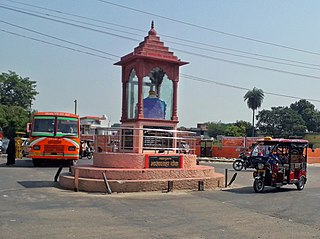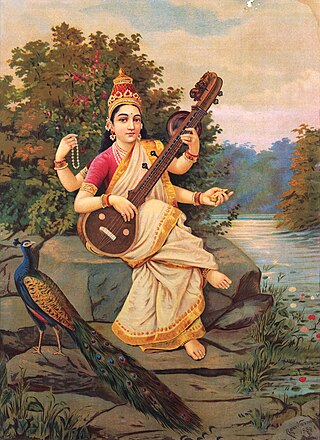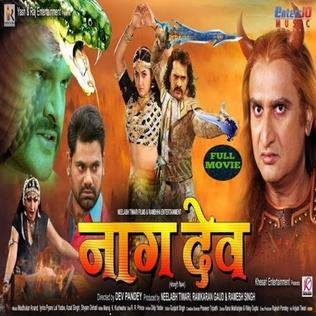Nordic folklore is the folklore of Denmark, Norway, Sweden, Iceland and the Faroe Islands. It has common roots with, and has been under mutual influence with, folklore in England, Germany, the Low Countries, the Baltic countries, Finland and Sápmi. Folklore is a concept encompassing expressive traditions of a particular culture or group. The peoples of Scandinavia are heterogenous, as are the oral genres and material culture that has been common in their lands. However, there are some commonalities across Scandinavian folkloric traditions, among them a common ground in elements from Norse mythology as well as Christian conceptions of the world.

Bhojpuri is an Indo-Aryan language native to the Bhojpur-Purvanchal region of India and the Terai region of Nepal. It is chiefly spoken in eastern Uttar Pradesh, and western Bihar. It is an eastern Indo Aryan language and as of 2000 is spoken by about 5% of India's population. Bhojpuri is a descendant of Magadhi Prakrit and is related to Maithili, Magahi, Bangla, Odia, Assamese, and other eastern Indo-Aryan languages.

The Gondi (Gōṇḍī) or Gond people, who refer to themselves as "Koitur", are an ethnolinguistic group in India. Their native language, Gondi, belongs to the Dravidian family. They are spread over the states of Madhya Pradesh, Maharashtra, Chhattisgarh, Uttar Pradesh, Telangana, Andhra Pradesh, Bihar, and Odisha. They are listed as a Scheduled Tribe for the purpose of India's system of reservation.
The folklore of India encompasses the folklore of the nation of India and the Indian subcontinent. India is an ethnically and religiously diverse country. Given this diversity, it is difficult to generalize the vast folklore of India as a unit.

Budaun is a medieval city and headquarters of Budaun district, Uttar Pradesh, India. It is located about a mile east of the Sot river, and 27 km north of the river Ganges, in the Rohilkhand region of Uttar Pradesh. According to the 2011 census, it has a total population of 159,221, which is projected at 161,555 at present. Budaun rose to historical importance as the capital of the Delhi Sultanate for four years from 1210 CE to 1214 CE during the reign of Sultan Iltutmish. It was the most important post of Northern Frontier during Mughal reign. Budaun is a big market, historically famous and religiously important city. Budaun is 230 km south-east of New Delhi and 245 km north-west of Lucknow, both taking about 6 hours by road.

Ballia district is one of the districts of Uttar Pradesh, India. Ballia district is a part of Azamgarh division situated in the east of Uttar Pradesh. The main economic activity is agriculture. City is the district headquarters and commercial market of this district. It is the birthplace of former prime minister of India Chandra Sekhar Singh There are six tehsils in this district: Ballia, Bansdih, Rasra, Bairia, Sikandarpur and Belthara. Rasra is the second major commercial area of the district, having a government sugar mill and a cotton weaving industry. Though Ballia's core occupation is agriculture there are some additional small industries. Maniar is known for its bindi industry and is a major supplier.

Pakistani folklore encompasses the mythology, poetry, songs, dances and puppetry from Pakistan's various ethnic groups.

Vasant Panchami, also rendered Vasanta Panchami and Saraswati Puja in honour of the Hindu goddess Saraswati, is a festival that marks the preparation for the arrival of spring. The festival is celebrated in Indian religions in different ways depending on the region. Vasant Panchami also marks the start of preparation for Holika and Holi, which take place forty days later. The Vasant Utsava (festival) on Panchami is celebrated forty days before spring, because any season's transition period is 40 days, and after that, the season comes into full bloom.
Ahir or Aheer are a community of traditionally non-elite pastoralists in India, most members of which identify as being of the Indian Yadav community because they consider the two terms to be synonymous. The Ahirs are variously described as a caste, a clan, a community, a race and a tribe.
The Mālavikāgnimitram is a Sanskrit play by Kālidāsa. Based on some events of the reign of Pushyamitra Shunga, it is his first play.

Teejan Bai is an exponent of Pandavani, a traditional performing art form, from Chhattisgarh, in which she enacts tales from the Mahabharata, with musical accompaniments.
Rajasthani literature is an tradition in Indian literature dating to the 2nd millennium, which includes literature written in the Rajasthani language. An early form of Rajasthani started developing in the 11th century from Saurseni Prakrit as Maru-Gurjar or Gurjar Apabhramsa. Early Rajasthani literature was usually written by Charans. Earlier Rajasthani was known as Charani or Dingal, which was close to Gujarati. Medieval Rajasthani literature was mostly heroic poetry mentioning the great kings and fighters of Rajasthan. Rabindra Nath Tagore, a Bengali polymath, once said, "The heroic sentiment which is the essence of every song and couplet of a Rajasthani is peculiar emotion of its own of which, however, the whole country may be proud". It is generally agreed that modern Rajasthani literature began with the works of Suryamal Misran, including the Vansa Bhaskara and the Vir Satsai. The Vansa Bhaskara contains accounts of the Rajput princes who ruled in what was then Rajputana, during the lifetime of the poet (1872–1952). The Vir Satsai is a collection of hundreds of couplets.

Rajauli is a tehsil, block and subdivision (sub–district) in Nawada district of Magadh division of the Indian state of Bihar. The tehsil of Rajauli is located at a distance of about 30 kilometres (19 mi) from Nawada city on National Highway 20 and is situated on the bank of Dhanarjay river. Rajauli, a Scheduled Caste (SC) reserved Assembly Constituency (AC) seat, had a total of 302900 electors during the 2015 Bihar Legislative Assembly election. Rajauli subdivision consists of 95 panchayats and 688 revenue villages while Rajauli block consists of 17 panchayats and 169 revenue villages.
Veer Lorik is part of the Bhojpuri folklore of Bihar and eastern Uttar Pradesh, India. According to S.M. Pandey, it is considered to be the Ramayana by the Ahir. Veer Lorik is a divine character of the legend of the Ahir of eastern Uttar Pradesh. The Veer Lorik Stone on the banks of the Son River in the Sonbhadra, Uttar Pradesh, contains a love story. He is sometimes known as the Lorikayan, after the folkloric tale of that name.
Bhojpuri literature includes literature written in Bhojpuri language. Bhojpuri has developed over a course of 1300 years, the development of the language started in 7th century. The earliest form of Bhojpuri can be seen in the writings of Siddha Saints and Charyapada. Distinct literary traditions in Bhojpuri language date back to medieval periods when saints and bhakts of the region adapted a mixed language for their works.
Raut is an Indian caste, whose traditional occupation is herding.

Nirahua Hindustani 3 is a 2018 Indian Bhojpuri-language action romance comedy film directed by Manjul Thakur and produced by Pravesh Lal Yadav under banner of "Nirahua Entertainment Pvt Ltd". Dinesh Lal Yadav in leading role along with Amrapali Dubey and Shubhi Sharma. Sanjay Pandey, Kiran Yadav, Samarth Chaturvedi, Ashish Shendre, Pallavi Koli, Oshin Kamboj, Samarth Chaturvedi, Ritu Pandey, Shweta Verma and Sanjay Mahanand feature in supporting roles.

Naagdev is a 2018 Indian, Bhojpuri language action- drama film directed by Dev Pandey and produced by Neelabh Tiwari, Ram Karan Gaud and Ramesh Singh under banner of "Rambha Entertainment" and "Neelabh Tiwari Films". Starring Khesari Lal Yadav in the lead role and Kajal Raghwani in an opposite role. Awadhesh Mishra, Dev Singh, Ritu Pandey, Vinod Mishra, Anoop Arora, Samarth Chaturvedi, J Neelam, Maya Yadav, Reena Rani, Prakash Jais, Sanjay Mahanand, Priya Sharma, Rohit Singh "Matru" and Sweety Singh play supporting roles, this film was first to introduce Vfx in Bhojpuri cinema.
Krishnaut or Kishnaut Ahir is a subclan of the Yadav (Ahir) caste found in Bihar, Jharkhand and Nepal. The term Krishnaut which to them denotes their descent from Lord Krishna.
Yadavs in Bihar refers to the people of Yadav community of the Indian state of Bihar. They are also known as Ahir, Gope, etc. The Yadavs form nearly 14.26 % of the state's population and are included in the Other Backward Class category in the Bihar state of India. Ahirs are among the land owning caste in the plains of Bihar.









